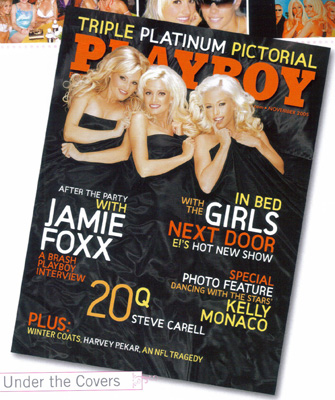
 |
I will examine the reality television show as a whole under the concept of audiencing, which assesses, "whether and how audiences take up [what is offered]: whether they affirm dominant order as it is articulated through an image, or whether they resist it in some way" (Rose 198). Basically, it is the notion that viewers interact with images as objects, and focuses on how audiences interpret what they see. Reality television is a relatively new genre of media, and yet it has become enormously popular since the creation of its format in 1992, with the premiere of the show "Survivor." Many different shows have followed in its basic footsteps, i ncluding The Girls Next Door, which chronicles the "real" lives of the women living in the Playboy mansion. Audiencing studies of other reality television shows will be useful in examining the motivation for viewing The Girls Next Door, whether viewers like and accept what they see, and if it actually influences behavior. |
It is common knowledge that most modern television shows contain sexual content and references, and reality television,
including The Girls Next Door, is no exception to the rule. A study by Janna L. Kim entitled, "From Sex to Sexuality: Exposing
the Heterosexual Script on Primetime Network Television" provides concrete evidence of this. The study assessed 25 primetime
television programs frequently viewed by adolescents, and watched for specific codes that indicated or pointed to a
"heterosexual script." "Situated in positions of power, men enact the Heterosexual Script by actively pursuing sexual
relationships, treating women as sexual objects, experiencing their sexual feelings as uncontrollable, being demanding
in sexual situations, rejecting homosexual feelings or behavior, appropriating female sexual desire, and avoiding commitment
and emotional attachment with women" (Kim 147). 51 total hours of television were observed from this study, and the heterosexual
script or code was observed a total of 662 times. This was the code that was observed most throughout these television shows,
and concluded with the findings that, "Men are preoccupied with women's bodies...Men are constantly consumed by sexual thoughts,
fantasies, and urges...Men talk openly about their sexual desires and fantasies...Men are sexual initiators" (Kim 150-151).
|
The second most observed code in these television programs pertained to feminine courtship patterns, and found that, "Women can/do/should objectify themselves...Women are valued primarily for their physical appearance...Women use passive and alluring strategies to win men's affection" (Kim 151-152). The television show The Girls Next Door corresponds to these findings as well, but mostly focuses on the code of feminine courtship patterns, because there are not many opportunities on the show for the heterosexual script to be actively enacted by men, since the show almost completely focuses on the thoughts, actions and visual images of the three women. Hugh Heffner is the only major male character on the show, and he really takes a "backseat" position on the show, and does not have nearly as much "face time" in the actual episodes as Holly, Bridget and Kendra do. Rose describes encoding as, "when a particular code becomes part of the semiotic structure of an image" (Rose 199). As observed from Kim's study of codes observed on a large range of television shows, the most dominant codes in television show men in positions of sexual power, and women as objectified by men, and even objectifying themselves as objects of sexual desire. This has truly become the "dominant code" in society, because it "supports the existing political, economic, social and cultural order" (Rose 199). This dominant code is referred to as hegemony, because it is power that is maintained through culturally constituted norms. |
 |
|
Although there is much research on audience studies and television in general, there is not much research on the specific genre of reality television. However, Danielle M. Stern completed one such study on the reality television show "The Real World," in a study entitled, "MTV, Reality Television and the Commodification of Female Sexuality in the The Real World." Stern argues that, "females are bearing the brunt of sexual exploitation via television representations that reinforce traditional views of gender and power" (Stern 15). In other words, the showing of females as objects of sexual desire on reality television is adhering to and confirming the hegemony that exists in society today. Stern conducted a group interview of seven young women, aged 19 to 34, and asked them questions related to their perception of The Real World. She noted that a group interview session was beneficial because it allowed the women to discuss the show in a public setting. "Media consumption is a social activity that involves people interacting with and relating to other people. As such, the discussion of television should also be interactive, allowing for subjects to share ideas and generate discussion" (Stern 16). The conversation was initiated by asking the women if they were offended by the shows portrayal of women. Like The Girls Next Door, the show often portrays women in scantily clad outfits, out "partying," and also in everyday normal situations. |
 |
Most of the women were not offended by the shows portrayal of women. One woman commented that, "It's not representing
all women. It's just them. They're the ones making fools out of themselves" (Stern 16). Almost all of the answers
pointed toward the shared belief that this was exactly the appeal of the show. They observed and agreed that the women
on the show knew they were being manipulated and exploited, and this surrealness was what intrigued viewers to
continue to watch the show. When the subject of stereotypes within the show was brought up, the women agreed that it
was the stereotypes portrayed along with "shock value" that truly showed the "non-reality" of the program.
 |
In conclusion, the women recognized the constructedness of the reality television show, but still enjoyed watching it and some even said they were considering applying to be on the television show. They know that, "women today are voyeurs who love to play for the camera as well as revel in its images. They know that sex sells" (Stern 20). Like the findings in Kim's study on codes in television shows, men are not the only ones that objectify women, but instead women willingly objectify themselves. The women in the study agreed that there was little to do to change this hegemony as well. Stern summarized the attitudes of the women in that, "women of this generation, in our twenties and thirties, appear to be numb-as the group framed it-to stereotypical images of beautiful, sex-fueled bimbos...the male gaze appears to have been naturalized into a myth of entertainment" (Stern 20). This study of women's perceptions of the real world works closely with audience study of The Girls Next Door because the same findings can be applied. While there are male viewers of The Girls Next Door, my personal observation and findings are that many more women are avid fans of the show than men. "I like the show because it is fun to watch, I know that this is not 'real life' or a direct representation of how all women act or should behave. Anyone who bases their perceptions solely on shows like this does not need to be watching television in the first place" said Paige Thompson, a 21 year old fan of the show. Like the women commenting on the Real World, Paige and other viewers of The Girls Next Door watch the show for entertainment value, and do not use the show to question and criticize the hegemony and dominant codes that exist in society today. |